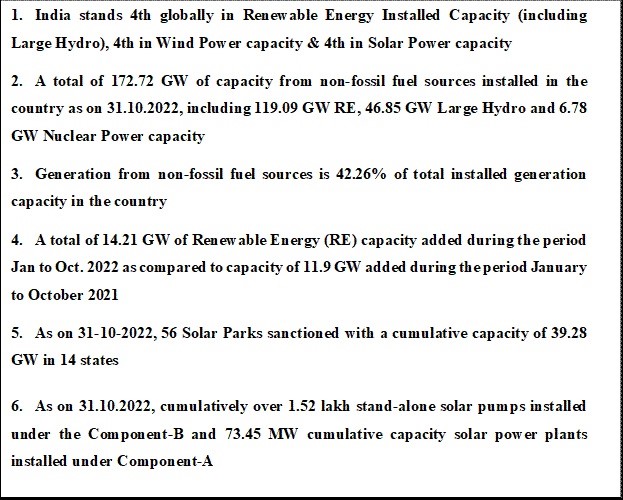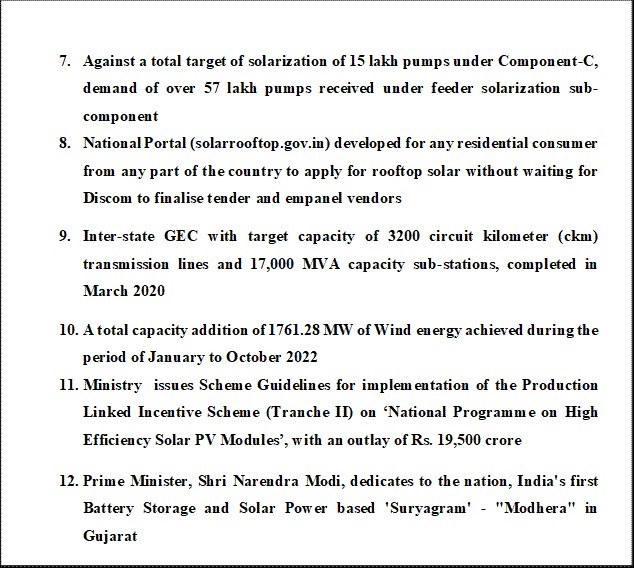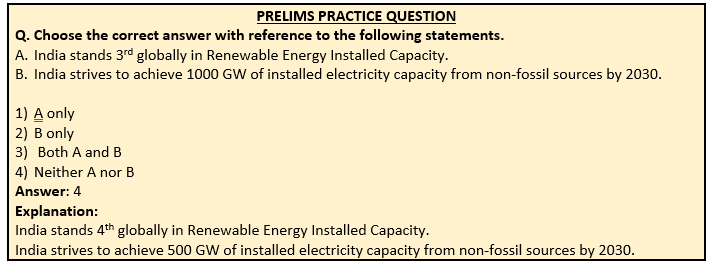
Disclaimer: Copyright infringement not intended.
Context:
- Recently, the year-end Review 2022 was released by – the Ministry of New and Renewable Energy.
Highlights of the Year End Review:


Energy from Non-fossil sources:
- In line with Prime Minister’s announcement at COP26, Ministry of New and Renewable Energy is working towards achieving 500 GW of installed electricity capacity from non-fossil sources by 2030.
- So far, a total of 172.72 GW of capacity from non-fossil fuel sources has been installed in the country as on 31.10.2022.
- This includes 119.09 GW RE, 46.85 GW Large Hydro and 6.78 GW Nuclear Power capacity. This has a share of 42.26% of total installed generation capacity in the country i.e. 408.71 GW as on 31.10.2022.
Renewable Energy Installed Capacity:
- India stands 4th globally in Renewable Energy Installed Capacity (including Large Hydro), 4th in Wind Power capacity & 4th in Solar Power capacity (as per REN21 Renewables 2022 Global Status Report).
.jpeg)
Simplified procedure on RTS:
- To simplify the implementation process, Ministry has developed a National Portal (solarrooftop.gov.in) wherein any residential consumer from any part of the country can apply for rooftop solar without waiting for Discom to finalize tender and empanel vendors.
Intra-State GEC Phase-II (InSTS GEC-II) scheme:
- The Intra-State GEC Phase-II (InSTS GEC-II) scheme was approved by the CCEA in January 2022. The total target is 10750 ckm intra-state transmission lines and 27500 MVA sub-stations with scheduled commissioning timeline of March 2026.
‘National Programme on High-Efficiency Solar PV Modules’:
- Production Linked Incentive Scheme (Tranche II) on ‘National Programme on High Efficiency Solar PV Modules’, with an outlay of Rs. 19,500 crore was approved and launched.
Solarisation of sun-temple and town of Modhera, Gujarat:
- Prime Minister, Shri Narendra Modi, dedicated to the nation, India's first Battery Storage and Solar Power based 'Suryagram' - "Modhera" in Gujarat. Imposition of Basic Customs Duty (BCD) on solar cells & modules was done away by the Ministry .
National Bioenergy Programme:
- The National Bioenergy Programme which comprises the following Sub-schemes was launched on 2.11.2022:
-
- Waste to Energy Programme (Programme on Energy from Urban, Industrial and Agricultural Wastes/ Residues)
- Biomass Programme (Scheme to support Manufacturing of Briquettes & Pellets and Promotion of Biomass (non-bagasse) based cogeneration in Industries.
- Biogas Programme: for promotion of family-type Biogas plants.
Vayumitra and Jalmitra Skill Development Programme under Human Resource Development Scheme were launched in 2022
Read: https://www.iasgyan.in/daily-current-affairs/bio-energy
Solar Parks Scheme:
- To facilitate large scale grid-connected solar power projects, a scheme for “Development of Solar Parks and Ultra Mega Solar Power Projects” is under implementation with a target capacity of 40 GW capacity by March 2024.
- Solar Parks provide solar power developers with a plug and play model, by facilitating necessary infrastructure like land, power evacuation facilities, road connectivity, water facility etc. along with all statutory clearances.
- 56 Solar Parks have been sanctioned with a cumulative capacity of 39.28 GW in 14 states. Solar power projects of an aggregate capacity of over 10 GW have already been commissioned in 17 parks and the remaining parks are at various stages of implementation.
- Solar projects of capacity 832 MW have been commissioned in various Solar Parks during period January to October, 2022.
Read: https://www.iasgyan.in/daily-current-affairs/solar-parks

PM-KUSUM Scheme:
Pradhan Mantri Kisan Urja Suraksha evam Utthaan Mahaabhiyan (PM-KUSUM):
- To provide energy and water security, de-dieselise the farm sector and also generate additional income for farmers by producing solar power, Government launched PM-KUSUM Scheme for farmers. The Scheme consists of three components:
-
- Component A: Installation of 10,000 MW of Decentralized Grid Connected Solar Power Plants each of capacity up to 2 MW
- Component B: Setting up of 20 lakh standalone Solar Powered Agriculture Pumps
- Component C: Solarisation of 15 Lakh existing Grid-connected Agriculture Pumps
- The Scheme aims to add 30.8 GW of solar capacity with central financial support of over Rs. 34,000 Crore.
Read: https://www.iasgyan.in/daily-current-affairs/pm-kusum-scheme-38
Solar Rooftop:
- Cumulative installed capacity (with or without Central Financial Assistance -CFA)-7.2 GW
- Capacity sanctioned for Central Financial Assistance (CFA)- Around 5.5 GW (i.e. 2.1 GW under phase I and 3.4 GW under phase II)
- Capacity installed with CFA- 2.838 GW (i.e. 1.350 GW under phase I and 1.488 GW under phase II)
Simplified procedure on Rooftop Solar (RTS):
- To simplify the implementation process, Ministry has developed a National Portal (solarrooftop.gov.in) wherein any residential consumer from any part of the country can apply for rooftop solar without waiting for Discom to finalise tender and empanel vendors.
- The subsidy is fixed and is same for the entire country.
Off-Grid Solar:
Off-grid Decentralized and Solar PV Applications Programme Phase III
- Phase III of the Off-grid Decentralized and Solar PV Applications Programme for Solar Street Lights, Solar Study Lamps and Solar Power Packs was available till 31.03.2021.
- In the current year, a total of 56,670 nos. of solar study lamps were distributed. During the closure of the installation of the programme, over 1.46 lakh solar street lights were installed, 9.71 lakh solar study lamps were distributed and 2.5 MW solar power packs have been set up as reported by State Nodal Agencies (SNAs).
Atal Jyoti Yojana (AJAY) Phase-II:
- The AJAY Ph-II Scheme for installation of solar street lights with 25% fund contribution from MPLAD Funds was discontinued from 1 April 2020 as the Government decided to suspend the MPLAD Funds for the next two years i.e. 2020-21 and 2021-22.
- During the closure of the installation of the programme, over 1.37 lakh solar streetlights were installed.
- Ministry issued a Framework for the Promotion of DRE (Decentralized Renewable Energy) Livelihood Applications with the objective to facilitate the development of an enabling ecosystem for widespread access to DRE for promoting sustainable livelihoods in the country including in rural and remote areas.
Green Energy Corridor:
- In order to facilitate renewable power evacuation and reshape the grid for future requirements, the Green Energy Corridor (GEC) projects have been initiated.
- During the calendar year a total of 183 km of transmission lines have been commissioned and 4930 MVA capacity of substations have been charged.
- Further to above, the Intra-State GEC Phase-II (InSTS GEC-II) scheme was approved by the CCEA in January 2022. The total target is 10750 ckm intra-state transmission lines and 27500 MVA sub-stations with scheduled commissioning timeline of March 2026. The InSTS GEC-II scheme is currently under implementation by the State Transmission Utilities (STUs) of 7 States, i.e. Gujarat, Himachal Pradesh, Karnataka, Kerala, Rajasthan, Tamil Nadu and Uttar Pradesh.
Wind Energy:
- A total capacity addition of 1761.28 MW has been achieved during the period of January to October 2022.
Other achievements
a. Amendments in ‘Guidelines for Tariff Based Competitive Bidding Process for Procurement of Power from Grid Connected Wind Solar Hybrid Projects.
I. Amendment dated 09.03.2022: Authorized representatives of procurers are allowed to conduct bidding process on behalf of procurers. Commissioning schedule of hybrid projects increased from 18 months to 24 months.
II. Amendment dated 02.11.2022: Provision relating to delay in Commissioning on account of delay in LTA Operationalization is rationalized.
b. On the basis of MNRE’s recommendation, concessional custom duty benefit (CCDC) for several wind turbine components has been extended till 31.03.2023 vide Ministry of Finance vide its Notification No. 02/2022-Customs dated 01.02.2022.
c. Draft National Repowering Policy for Wind Power Projects, 2022 has been issued for stakeholders consultation. The objectives of the Repowering Policy are optimum utilization of Wind energy resource by maximizing energy (kWh) yield per sq.km of the project area and utilizing the latest state-ofthe art onshore Wind turbine technologies.
Offshore Wind:
d. Strategy paper including business models for offshore wind energy has been issued. This provides roadmap for achieving 30 GW of offshore wind energy target by 2030.
e. Draft Offshore Wind Energy Lease Rules, 2022 have been finalized and sent for legal vetting.
Read: https://www.iasgyan.in/daily-current-affairs/wind-energy
Bioenergy:
The following Bioenergy schemes are under implementation by the Ministry:
-
- Programme on Energy from Urban, Industrial and Agricultural Wastes/ Residues
- Scheme to Support Promotion of Manufacturing of Briquettes & Pellets and Biomass (Non-Bagasse) Based Cogeneration in Industries in the Country for the period from FY 2021-22 to 2025-26.
- Biogas Power (Off-Grid) Generation and Thermal application Programme (BPGTP)
- New National Biogas and Organic Manure Programme (NNBOMP)
- A total capacity of 30 MW has been achieved in the year of 2022. Cumulative installed capacity of biomass power and cogeneration projects stood at about 9.4 GW (Bagasse & IPP) and 0.77 GW (Non-Bagasse), waste to energy projects capacity was 223.14 MW (grid connected) and 272.09 MWeq (off-grid).
Read: https://www.iasgyan.in/daily-current-affairs/bio-energy
National Green Hydrogen Mission:
- In the Independence Day address on 15 August 2021, Hon’ble Prime Minister announced the National Green Hydrogen Mission and stated the goal to make India the global hub of Green Hydrogen production and export.
- MNRE is accordingly developing the National Green Hydrogen Mission with the objectives of decarbonising major economic sectors, making India energy independent and serving as an inspiration for the global clean energy transition. The Expenditure Finance Committee (EFC) approved the proposal on the National Green Hydrogen Mission in April 2022.
- Ministry of Power notified provisions for facilitative open access and banking of renewable energy for Green Hydrogen production vide the Green Open Access Rules.
- Working Group has been constituted under the chairmanship of Secretary, MNRE for development of Regulations, Codes and Standards framework for Green Hydrogen. The Group has undertaken mapping and gap analysis of all relevant standards and regulations.
- The Ministry undertook stakeholder consultations and put forth views India’s views at international forums on regulations for certifying Green Hydrogen and its derivative fuels. Detailed comments on the EU specifications on renewable fuels were provided through our Embassy in Brussels. This resulted in relaxation of EU specifications.
- Draft bidding guidelines for Green Hydrogen and Green Ammonia have been prepared. The model guidelines will be useful, particularly for Bidding for Green Ammonia initially.
- Bilateral cooperation activities on hydrogen have been initiated with several countries including USA, Germany, France, Australia, Japan, and the UK. Task forces on hydrogen have been constituted with US and Germany, and India is leading active technical cooperation on Hydrogen in the Quad.
- MNRE is also leading the track on hydrogen under the Energy Transition Working Group for India’s G-20 presidency.
Read: https://www.iasgyan.in/daily-current-affairs/national-hydrogen-mission-45
International Solar Alliance:
- International Solar Alliance (ISA) was launched by Hon’ble Prime Minister of India, and the President of in 2015 at Paris, France. With the signing and ratification of the ISA Framework Agreement by 15 countries, on 06.12.2017, ISA became the first international intergovernmental organization to be headquartered in India.
- In 2020, an amendment came into force, which enables all member States of the UN, including those beyond the tropics, to join the ISA.
- 110 countries have signed the Framework Agreement of the ISA. Of these, 90 countries have also ratified the same. The fifth Assembly of International Solar Alliance was held on 18.10.2022. India and France have been re-elected as the President and Co-President of ISA Assembly for a third consecutive two year term for the period Oct-2022 to Oct – 2024.
Read: https://www.iasgyan.in/daily-current-affairs/international-solar-alliance-15




















